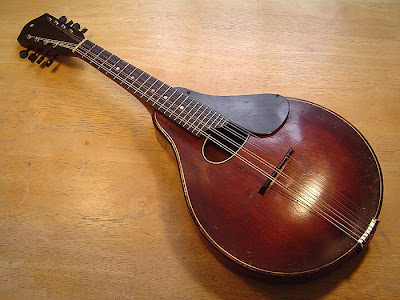c.1930 Stradolin Mandolin

Let me first say: this is one hell of a mandolin! It has bark, bite, dark and woody tone, and loads of volume. The playability is excellent, it's durable (as evidenced by the many prior repairs before it got into my hands), and it's pretty much the ideal bluegrass mandolin: great worn-in character, and that "Gibsonite" A-style sound (though I must say, I prefer this mandolin to a Gibson any day).

Though unmarked, this mandolin matches up with other mandolins marketed under the early Stradolin name. It also features the early quality of those mandolins: all-solid wood! Maple neck, sides, flamed maple back, spruce carved-top, etc. Dyed pearwood fingerboard, rosewood bridge and nut. And plenty of good vibes! Needless to say, it's fled the depression down south and now lives in backwoods Canada!

This mando has a 14"+ scale (can't quite remember) and a nice wide fretboard. These plain light Martin 80/20 strings sounded great on it. Pearl dots.

Original fitted bridge.

Tailpiece missing its cover.

Simple headstock with bone nut. Tuners were originally a set of damaged Waverlys. Now they're generic c.1925 bakelite mando tuners, but they work just fine.

As you can see - a lot of wear and tear, but still lookin' fine. This whole mandolin had bright scratch marks all over it and cloudy finish head-to-toe (especially on the back) which I managed to clean up and minimize. I had to reglue portions of the back (which had apparently been reglued before) and also portions of the top, which had become loose.

Here's the back, with the big long crack that was repaired before my time. This entire back surface was practically white with clouded finish, extra glue, and yuck. Notice the missing heel cap.

"New" '20s tuners.

Yeah-huh! Someone loved playing this guy.

Glam shot: the fingerboard extension combined with the double-bound oval hole looks really nice. Original pickguard, too! One neat thing about this mando is that the vibrating length of the string from the tailpiece to the bridge is just right so that when you pluck a pair of strings below the bridge they correspond with a note (in tune!) of the open string after the string you're playing. Thus: pluck the D string course below the bridge and it's an A, the A string course below and it's an E... etc. This makes for some very interesting solo and sympathetic styles if you want to get right into it (which I did, as I used this mando briefly for a production of the musical Woody Guthrie's American Song).

And last but not least -- real purfling as opposed to a pinstripe of paint gives this mando some class!

Comments
You can find vintage tuners on eBay from time to time or steal them from a really botched instrument at flea markets/eBay/etc.